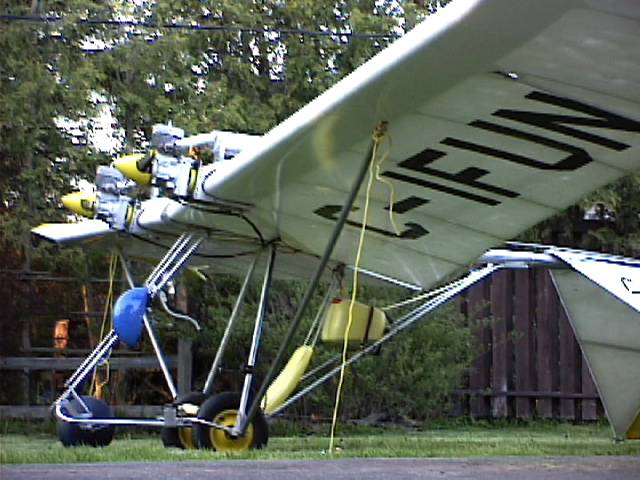|
7.1
CHECK YOUR NOSEWHEEL AXLE
While doing some
modifications to one of our demonstrators recently we noticed a
considerable amount of wear on the nosewheel axle.
This particular aircraft had made many beach landings last summer
and it is probable that much of the wear was caused by sand in the
nosewheel bushings. While a
worn nosewheel axle might not seem like a serious problem, it could be
serious on a Lazair equipped
with rudder pedals. If the
axle is worn sufficiently, to cause an appreciable stress concentration,
applying pressure to both rudder pedals simultaneously could cause the
axle to fracture and result in the loss of rudder pedal control.
This has not happened, and it is unlikely that it ever will, but
your nosewheel axle should be checked for wear at least after every 50
hours of flying time, and replaced if necessary.
If you land and take off in sandy areas, the checks should be
made more frequently.
7.2
PIONEER CYLINDER HEADS
In an early notice to
customers (before we began
distributing these "green sheets"), owners of Pioneer powered
Lazairs were advised that some of the Pioneer engines had developed
cracks in the cylinder head. Since there are a few of the early Lazairs
still flying with Pioneer engines, this information is provided again.
The earlier Pioneer engines seem to be most susceptible to this
problem, although many have flown several hundred hours without
difficulty. The second
generation of Pioneer heads incorporated a vertical web between the
cooling fins directly behind the decompressor boss.
While this did not eliminate the problem completely, it certainly
reduced it. The people at
Pioneer suggested that some of the problems may have been caused by a
leaky decompressor which can cause a hot spot in the cylinder head and
therefore contribute to the cracking.
By replacing the decompressor with a suitable length 5/1&UNF
bolt and gasket, this potential problem can be eliminated.
These engines are small enough to make the decompressor
unnecessary for starting. However, the most probable cause of this
problem is insufficient lubrication which causes the head to overheat.
As with all two-stroke engines, the Pioneer must be run with a
rich fuel mixture. A
mixture which is too lean can result in serious damage.
When adjusting the high speed mixture screw on the carburetor, it
should be turned in until the engine just begins to slow down, then the
screw should be backed out one quarter to one half a turn.
-
1.3
"CLEAR THE PROP!"
Propellers are dangerous.
Propellers can be lethal! Aside
from the obvious discomfort if you should inadvertently stick your
finger (or your head) into a spinning propeller, you should be aware
that any propeller regardless of its material or method of manufacture
could possibly break. While
the statistical probability of any particular propeller breaking is very
low, it is nonetheless, possible. The
tensile stress in a spinning propeller can be very high.
The acceleration at the tip of a 30 inch diameter prop turning at
6,000 RPM is over 15,000 g's. No,
that's not a misprint, it really is fifteen thousand g's. This means
that an imbalance of only one tenth of an ounce at the tip of the prop
would produce a force of almost a hundred pounds pulling the prop shaft,
first one direction, then, 5 milliseconds later, in the opposite
direction.
Clear the prop
This
type of oscillating force can not only destroy crankshaft or driveshaft
bearings, but can result in a fatigue failure of the crankshaft and even
the propeller itself. Any
tendency to fatigue can be aggravated by nicks or scratches in the prop,
overtorquing or undertorquing the prop bolts, foreign material
between the propeller and the mounting flange, and
discontinuities in the propeller material. Potential problems can be
lessened at the design stage by making props from homogeneous materials
rather than materials such as wood, by keeping the nominal blade weight
to a minimum, especially near the tips where the acceleration
is highest, and by using a manufacturing process which makes the
propeller as symmetrical as possible.
Post manufacturing fixes such as static balancing may help but a
statically balanced propeller will not necessarily be balanced at all
operating speeds.
The
propeller designed for the Lazair has
been tested at 9,000 RPM (1.5 times the normal maximum operating speed
of 5,800 RPM). This
creates a tensile force nearly two and one half times the force which
would be encountered in
normal service, and provides an adequate safety factor for normal
operation. However, using
these propellers at higher speeds can
increase the stresses substantially (since the tensile force is
proportional to the square
of the RPM). In
addition to this, increasing the speed will increase the probability of
tip flutter. Tip flutter will
increase the temperature of the tips, which reduces the flexural
strength and causes even more flutter.
Even
if a propeller Is not abused there is no absolute guarantee that
it will never fail. In the
past year, we have had reports of three propellers breaking in flight. Fortunately there were no injuries caused by flying fragments,
but had this happened with the aircraft on the ground and a bystander in
just the wrong place, it
could have been much more serious.
While three broken props out of the approximately 2,000 which are
now on Lazairs, Is not a record of which we are particularly proud, it
is probably better than what could be achieved with wooden props under
the same operating conditions. There
is no reason to expect that one of your props will fail, and we don't
wish to cause any paranoia, but the props on your Lazair's (and the
props on every other ultralight) should be treated with respect.
Inspect them frequently. Keep
them clean, file or sand out any small nicks or scratches, do not do
anything which could upset the balance, and, above all, do not allow
bystanders to stand in the plane of rotation while you do your engine
run-up. When you are around
other ultralights, observe the same precautions and stay behind the
propeller. At the Oshkosh
Fly-In alone last year there were three incidences of propellers flying
apart (none of them on a Lazairs) so remember -- It can happen.
Although
the probability of losing a propeller In flight Is remote, it is a
possibility. However,
unlike the situation in a larger aircraft, the loss of a prop (or any
other problem which initiates a forced landing) should not, under most
circumstances, result in damage to the aircraft or injury to the pilot.
Ultralight pilots have a very significant advantage over other
pilots in this regard because in most areas, it is possible to fly an
ultralight so that there is always a safe landing site within gliding
distance. This is not the
case if you're flying a Lear Jet or even a Cessna 150.
While it's almost always possible to keep a landing spot in
sight, most of us don't always do so. The next time you're showing your friends how low you can
fly, ask yourself "What would I do if an engine quit -- right
now?". Maybe you will
decide that a bit more altitude would be prudent.
|



